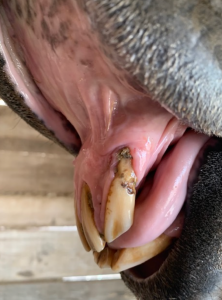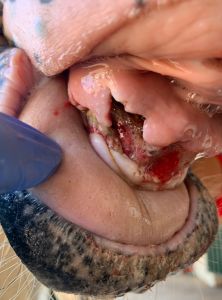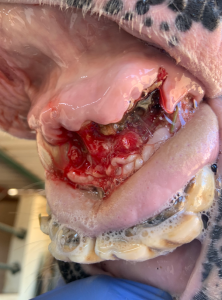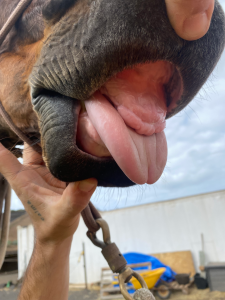If there is one thing that worries us at AnimalFeel’s equine medicine service team, it is the dental health of our patients, which is why we want to talk to you about a disease that we are encountering more and more in our day-to-day work in the field!
Have you ever heard of EOTRH? It stands for “Equine Odontoclastic Tooth Resorption and Hypercementosis”, and it is a syndrome that causes an inflammatory, painful and progressive process that affects all equines (horses, ponies, donkeys…).
It is most commonly seen in animals over 15 years of age and its development is gradual, so we will start to see the lesions externally when they are actually already very extensive.
What happens in our patients is that we see that there is a resorption or loss of bone and tissue surrounding the roots of the incisors, and sometimes also the canines. These teeth are left with little or no attachment and are therefore unstable and move easily, but they are also brittle so there is a high risk of fracture. It is often accompanied by hypercementosis, i.e. a thickening of the roots of the teeth in order to compensate for the imbalance present.
The symptomatology that we observe is:
- Sensitivity, pain and irregular wear on the incisor teeth.
- Progressive weight loss.
- Retraction of the gingiva.
- Red spots (called petechiae) and bulb-shaped inflammation around the roots.
Mobility or even detachment of the affected teeth.
Our clients call us because they notice above all a change in their animal’s behaviour: they are irascible, apathetic, more angry and head-butting sideways very often. They are patients who have great difficulty eating, as their teeth hurt so much that they cannot break pellets or carrots with their incisors because they do not want to use force, hay falls out of their mouths and a lot of food accumulates between their incisors. On arrival at the surgery, it is usually very difficult to explore their mouths as they resist exploration due to the pain caused by any type of manipulation.
To diagnose this disease, we must carry out a radiological study to assess the change in density of the roots of the teeth and determine whether there are signs of resorption and/or cementosis. In this way, we can identify which teeth are affected and the extent of the lesions.
The treatment of choice for these patients is surgical: under deep sedation and using locoregional blocks, we will extract the affected teeth. In less than 2 months the patient will be back to normal!
But we’re reading your mind…. Can a horse live without its front teeth? We have good news, they can live a totally normal life! They have a super friendly recovery and their quality of life is greatly improved as the cause of their pain and discomfort has been eliminated.
Remember that the front teeth are only used to pick up food, as chewing occurs with the premolars and molars. Therefore, the function of these teeth can be perfectly substituted by the lips.
Do not forget to have your horse’s mouth checked annually. Early identification of any pathology such as EOTRH is key to have a better prognosis. Make an appointment with our team of specialists!

Surgery photos











